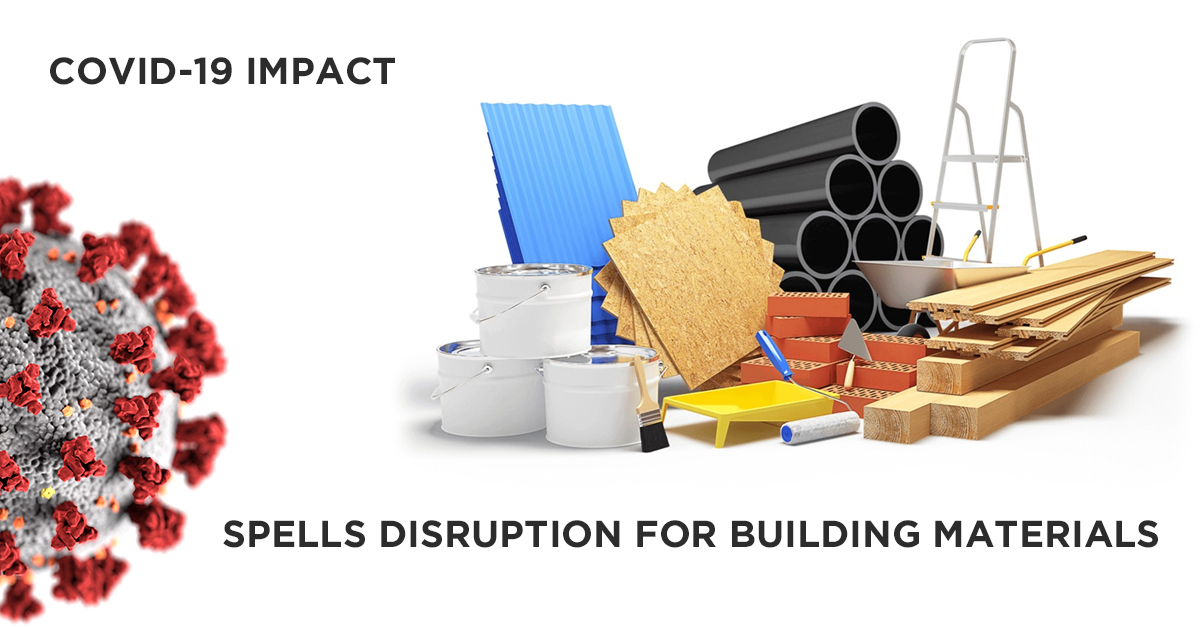COVID-19 impact spells disruption for building materials
What happens when a globalized economy, which relies on China, Mexico and Canada for 70% of its material requirements, faces supply-chain disruptions? The short answer is: Construction comes to a standstill, prices skyrocket and questions are raised. This was the case in the United States of America, after COVID-19 upended supply lines. Until then, the US was heavily reliant on China for plumbing components, elevator parts, fire protection items and electrical materials, among other hardware. Glass and Aluminium were sourced from across Europe – mostly from Spain, Italy and Lithuania(1). The fact that almost all of these countries experienced the worst effects of the contagion, only added to American construction’s materials and components woes. But the US’s supply-chain troubles are far from unique.
One disruption, widespread implications
An ardent proponent of globalization, at least prior to the current government, the US has played a vital role in shaping the supply-chain landscape across the globe. Services-led economies, including the US, had developed a dependency on manufacturing powerhouses like China, to procure materials. But COVID-19 outbreak halted production at scale, causing widespread disruptions. Worse, industry experts expect significant downtime before full scale production is restored. In any case, expecting supply-chain economics to return to pre-pandemic normalcy is a tall order, based on today’s rapidly shifting geo-political climate.
The change is already evident in end markets: Vendors have no ETA on new stock, inventories are depleted and available stock is selling at a premium. In addition, the pandemic has aggravated political differences between nations, which is taking its toll on existing supply-chain relations. In response, policymakers are taking decisions that could lead to new policies and supply-chain regulations.
We are also witnessing a recalibration of geo-political trade equations, based on the belief that China could have been more forthcoming with sharing information in the early stages of the pandemic. This disruption could lead to changes in global supply chains and favor a shift to manufacturers in India and south-east Asian economies as an alternative to previously established suppliers, a demand that India is well capable of handling.
The changing dynamics of demand-side economics could encourage material producers to serve markets where profit margins are high. This could lead to additional downtime in developing economies, where contractors could be priced-out, in procurement deals. Such an occurrence is particularly distressing for projects that are already under-construction with an earmarked budget, pre-set for an ETA on off-plan sales. The knock-on effect extends to lenders and financial institutions, who are already facing headwinds due to a recession-related paucity of liquidity. Even planned renovations, let alone new projects, could be postponed indefinitely.
But all this pales in comparison to the uncertainties in subcontractor markets, where the battle is on multiple fronts – including the inability to sustain the labor force and inadequate top-down support. Lack of inventory could mean subcontractors face extended downtime, possibly leading to bankruptcy and mass layoffs. As a secondary effect of this, when construction activities eventually resume, it could take additional time and effort to regroup and build capacity from scratch. However, in open labor markets like Dubai, the consequences could be less severe.
After inevitably entering into deals with a different supplier, resumed projects could face delays due to new materials posing design challenges, or worse — being incompatible, or having quality issues. It could lead to both visible and unseen disparities between units within the same project, depending on whether they were built before or after the pandemic. Naturally, experts advise careful consideration, before taking on new deals and procuring materials, even if it means additional time-consuming meetings and deliberations.
Navigating the new normal
The multifaceted disruptive effect, that construction is likely to face, requires effective communication across the board. Alternative supply chains could be explored, in line with geo-political status quo, changed policies and new opportunities. The emphasis needs to be on transparency, accountability and reliability. Risks and benefits associated with both local and global material manufacturers should be quantified and assessed. And since COVID-19 is a developing story, the calculation of a new lead time should factor in future possibilities.
As critical decisions are taken, the board must foster a two-way communication channel with subcontractors. A low-revenue environment could necessitate difficult decisions, like layoffs or activation of force majeure, etc. In such cases, information must be relayed effectively, without leaving room for ambiguities. Also, the situation could demand revision of contracts and insertion of new provisions, such as time extension and price escalation. It is vital to set new price thresholds, taking into account the fluctuations in the market. Along with addressing time-sensitive concerns, the “new normal” requires contingency planning for the long haul. This could mean a roadmap to rebuild capacity, or a redesign to shift dependency from high-risk suppliers.
The ongoing disruption is also likely to drive a focus on sustainable building materials. The construction industry was already under criticism for its disproportionate contribution to the global carbon footprint and climate change, prior to the COVID-19 crisis. A post-pandemic push for increased incorporation of three R’s – reduce, reuse and recycle – in construction, has led to a renewed focus on slag cement, sisal fiber-reinforced materials and smart options, such as shape memory alloys and nanostructures.
In fact, alternative materials and smart, innovation-led developments are likely to attract increased investments and entrepreneurial interest. In practice, once the alternative-material industry becomes truly embedded into a local construction sector, the impact can be felt across social, economic and environmental pillars of sustainability. Such innovations often attract subsidies and tax benefits from governments, and once holistic sustainability is achieved, the local market is better insulated from external disruptions – a strength which is likely to be highly valued in the post-COVID economy.
What can governments do?
Industry stalwarts believe timely economic initiatives could help avert insolvency among firms. This is perhaps why stimulus packages have disproportionately aimed at fortifying the financial markets, so that benefits can trickle down across business sectors. In the UAE, the economic package revised the existing limit on the maximum exposure that banks can have to the real estate sector.
Thankfully, however, UAE contractors are not facing significant challenges, according to an industry source(2). There are no shortages of key building materials, especially since Chinese suppliers have returned to full-capacity operations. But owing to slight price fluctuations, promoters are pushing for re-pricing of projects, which could change pre-pandemic cost-to-build estimates.
In recent years, the UAE government has taken noteworthy steps towards local manufacturing of steel and other building materials, aside from measures to near-shore important, high-end material supply. This has inarguably contributed to resilience against ongoing disruptions. The UAE is also pioneering sustainable developments, by promoting cutting-edge technology through favourable policies. On the whole, the UAE’s adaptability, openness to emerging technologies, and even-keeled foreign policy are likely to give the regional construction industry a head start, as construction activity resumes, post –COVID-19.




